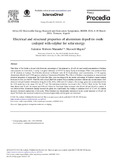Electrical and Structural Properties of Aluminium Doped tin Oxide Codoped with Sulphur for Solar Energy
Abstract
Thin films of Tin Oxide co-doped with 28 atomic percentages of Aluminium (i.e. 28 at% Al) and varied concentration of Sulphur were prepared on 1mm thick, 1cm by 1cm glass substrates at 470 0C by Spray Pyrolysis technique. Films were produced from 2.0M solution of hydrous Tin Chloride dissolved in Ethanol with 38% Hydrochloric acid concentration, 1.5M aqueous Aluminium chloride and 2.0M aqueous solution of Ammonium Sulphide. The effects of Sulphur concentration on structural and electrical properties of transparent Tin Oxide thin films were investigated in the atomic percentage of Sulphur content ranging from zero to fifty (i.e. 0at%S -50at%S) with a fixed 28at%Al content. Polycrystalline structures without any second phases were observed with preferential orientations along the (110), (101), (200) and (211) planes. The average grain size as determined from the (110) peaks lay in the range 19.2 nm-47.7nm. The minimum resistivity was found to be 1.15x10-3Ωcm for the Tin Oxide films doped with 32 at% Al content and 9.59x10-3Ωcm for Tin Oxide films co-doped with 28 at% Al and 20 at% S content. It was observed that Aluminium doping lowered the grain size significantly but doping to optimum level of 32 at% Al content increases electrical conductivity of tin oxide. When Sulphur was intentionally introduced in the crystal structure of 28 at% Al doped Tin Oxide, the electrical conductivity decreased appreciably and the grain size increased.
URI
https://doi.org/10.1016/j.egypro.2016.07.147https://www.sciencedirect.com/science/article/pii/S1876610216305744?via%3Dihub
http://ir-library.mmust.ac.ke:8080/xmlui/handle/123456789/2256
Collections
- Gold Collection [996]

